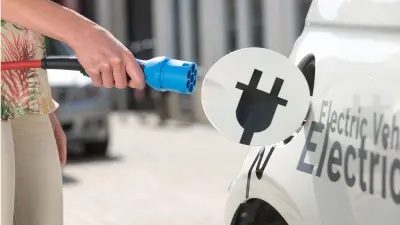Climate action — give us the full picture!

2018-10-15
When it comes to road-traffic CO₂ emissions, we need complete transparency: from fuel consumption to the production of fuel and electricity.
By Dr. Volkmar Denner
Climate change is growing in seriousness, but how serious are we about climate action? This is a question that concerns Dr. Volkmar Denner, the Bosch CEO. Road traffic is one of the factors contributing to the greenhouse effect. It is responsible for 18 percent of global CO₂ emissions. But a lot of progress has been made here: in Germany, the CO₂ emissions of newly registered vehicles have fallen by one quarter since 2007. And it doesn’t stop there: in the EU, Parliament, Council, and the Commission will soon be debating whether new vehicles’ CO₂ emissions should fall by 30 or 40 percent over the next decade. That said, limits on road-traffic emissions are only part of the picture. To fulfill them, we need consumption data that are as close to reality as possible. Moreover, if we continue to ignore the way fuel and electricity are generated, we will not be telling the whole story about road traffic’s carbon footprint. Anyone who takes climate action on our roads seriously must consider all sources of CO₂ emissions, from well to wheel. There can be no fight against climate change unless we are perfectly clear about CO₂ — that is the subject of this latest edition of “Denner’s view.”
“Anyone who takes climate action on our roads seriously must consider all sources of CO₂ emissions, from well to wheel.”
Climate change – end the lethargy
The ebb and flow of public concern for climate change is difficult to fathom. When the United States announced its withdrawal from the Paris climate agreement a year ago, there was a huge outcry. The criticism from Europe was justified, but it also had a touch of hypocrisy. After all, the German federal government has only just announced it is backing down from its own climate action targets for 2020, fatalistically saying that the targets were unachievable anyway. Such “remarkable inaction” in the face of a global emergency (to quote the Potsdam climatologist Hans Joachim Schellnhuber) seems to be practically without rhyme or reason. And very recently, the IPCC has said there is an urgent need for unprecedented changes if global warming is to be kept to a maximum of 1.5 degrees Celsius. How seriously are we taking the available forecasts, such as when the World Bank predicts nearly 140 million climate refugees by 2050? Do we think they’re merely being alarmist? What about the appeals to each one of us not to wait for others – whether legislators or international political bodies — to take action? In my view, the automotive industry can also do more to prevent global warming than our laws require. Above all, it should tackle it much less narrowly than in the past. What I’m appealing for is a fresh look at road traffic CO₂ — for the benefit of the environment, and of each individual driver as well.

Limits alone won’t cut it

In other words, I’m not only talking about the new limits the EU will set for the next decade. There’s also the question of what is measured. Two points are important here. The first is to measure real driving consumption, and by real, I mean as close to reality as possible. The second is to take a well-to-wheel perspective that considers the entire energy chain, from power stations and refineries to the vehicles themselves. We need to focus much more closely on both of these points. Only then will we see where more clearly where action is required in order to improve the carbon footprint of road traffic.
“Two points are important here. The first is to measure real driving consumption, and by real, I mean as close to reality as possible. The second is to take a well-to-wheel perspective that considers the entire energy chain, from power stations and refineries to the vehicles themselves.”
Toward real driving consumption
But how can we bring this about? Or, to put it differently, how can we steer a more realistic course toward efficiency and climate-action targets? The future application of the globally standardized WLTP test cycle is a step in the right direction. It’s also good that the European Union wants to mandate on-board measurements of new vehicle models’ consumption, and thus also their CO₂ emissions, in the next decade. There are still some issues to be resolved, as real consumption values can also fluctuate greatly, depending on factors such as driving style and whether the air-conditioning is on. Nonetheless, it appears that real driving consumption will be the EU benchmark for vehicles’ carbon footprints. This will create more transparency for consumers. Above all, it will allow the cost and benefit of any measure taken to reduce CO₂ emissions to be pinpointed more accurately.
80 grams CO₂
per kilometer would be the emission balance of a compact electric car, based on Germany’s energy mix.
The myth of climate-neutral electric vehicles
The more comprehensively we can measure CO₂ emissions, the more effective we can be in the fight against climate change. Nobody in favor of climate action can afford to ignore road traffic’s overall carbon footprint. In this respect, Bosch argues for taking a comprehensive view — “well to wheel,” right from the source in other words, instead of merely “tank to wheel.” When it comes to global climate, it is not just a vehicle’s direct emissions that count, but also the emissions from fuel production and electricity generation. We would like to see this overall footprint included in the next round of CO₂ legislation. If it is, drivers of electric vehicles will no longer be able to believe that their vehicles are carbon-neutral – that they emit zero CO₂, in other words. If Europe’s current energy mix were to be included in the calculation, a compact electric car would have a carbon footprint of 40 grams per kilometer — and if this is based on Germany’s energy mix, it would be as much as 80 grams.

Tweaking conventional vehicles — and electric ones


When it comes to their carbon footprints, combustion engines and electrical powertrains are not that far apart now, nor will they be in the near future. In other words, this is not a clear-cut choice between combustion engines and electric motors. It’s high time we stopped pitting one against the other. Instead, we have to apply the merits of both, as appropriate. Specifically, that means ensuring that combustion engines increase their use of lower-CO₂ fuels, and that electrical powertrains use more renewable energy. It may well be that dyed-in-the-wool climate activists would prefer a simpler solution — quite a few of them already believe the combustion engine should be consigned to the dustbin of history. I disagree, and strongly so: the more serious we are about climate action, the less simplistic our arguments have to be.